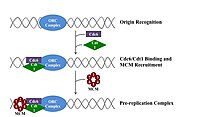
Photo from wikipedia
Background Patellar resurfacing is routinely performed during total knee arthroplasty to reduce pain associated with patellofemoral osteoarthritis. With 3-dimensional ingrowth materials readily available, the present study aimed to evaluate if… Click to show full abstract
Background Patellar resurfacing is routinely performed during total knee arthroplasty to reduce pain associated with patellofemoral osteoarthritis. With 3-dimensional ingrowth materials readily available, the present study aimed to evaluate if cemented polyethylene (CP) patellar buttons conferred higher ultimate load to failure than press-fit metal-backed (PF) buttons in axial compression. Material and methods Ten matched cadaveric and 20 composite patellae were resurfaced and implanted with either a PF or CP button. Biomechanical testing using an MTS machine was performed to measure the force required to generate a periprosthetic patella fracture. Mean load to failure and load to failure per 1-mm patellar thickness were compared with a paired and independent samples Students’ t-test for the cadaveric and composite patellae, respectively. Results The average load to failure for the matched cadaveric patellae with PF implants was significantly lower than that for patellae with CP buttons (4082.05 N vs 5898.37 N, P = .045). The average load to failure for composite patella with PF implants was significantly higher than that for composite patellae with CP implants (6004.09 N vs 4551.40 N, P = .001). The mean load to failure per 1-mm patellar thickness was also significantly higher for composite patellae with PF implants (263.80 N/mm vs 200.37 N/mm, P = .001). Conclusion Cadaveric patellae with cemented implants had a significantly higher ultimate load to failure in axial compression than press-fit patella. However, this result was reversed in the composite model. Exploration of biological and composite model properties could provide further insight into patellar implant selection during total knee arthroplasty.
Journal Title: Arthroplasty Today
Year Published: 2022
Link to full text (if available)
Share on Social Media: Sign Up to like & get
recommendations!